EX-AEQUO: a legacy of the Games
Longread
Updated on 21/08/2024

Cette page est aussi disponible en français
On the occasion of the Olympic and Paralympic Games in 2024, the City of Paris has deployed works of art in 24 Parisian sports facilities. This artistic program, developed as part of the Cultural Olympiad, brings art and sport together, is a legacy of the Games and highlights the vitality of Parisian creativity.
100 years after the last Summer Games in France, Paris is delighted to be hosting the Olympic and Paralympic Games in 2024. Based on projects combining art and sport, the Cultural Olympiad, in place since 2021, offers an exceptional artistic program, including the installation of some 30 works in 24 sports facilities in all arrondissements, to create a lasting exchange between sportswomen, sportsmen and visual art.
These works, which constitute an exceptional cultural legacy of the Paris 2024 Games, are representative of the diversity of contemporary aesthetics.
They have been imagined and created by artists, designers and students from the City of Paris' applied arts schools.
Chloé Dugit-Gros
Design of Chloé Dugit-Gros's "Super Powers" at the Maryse Hilsz Sports Center.
Chloé Dugit-Gros
Design of Chloé Dugit-Gros's "Super Powers" at the Maryse Hilsz Sports Center.
Playground, Nelson Mandela garden (central Paris)
Artists: EPSAA students (Marine Bezamat, France Bozdemir, Maud Brigand, Diane Cash, Caroline Chantalat, Inès Chastaing, Daria Chuvatin, Matthéo Comte, Juliette D'Angela, Angélique Danapoubady, Germain Diore, Calixte Dugelay)
Work: Playground, 2023. Graphic design on dibond sheet.

Playground, work by EPSAA students
Crédit photo :
Frederic Mauviel / Mairie de Paris

Playground, work by EPSAA students
Crédit photo :
Frederic Mauviel / Mairie de Paris
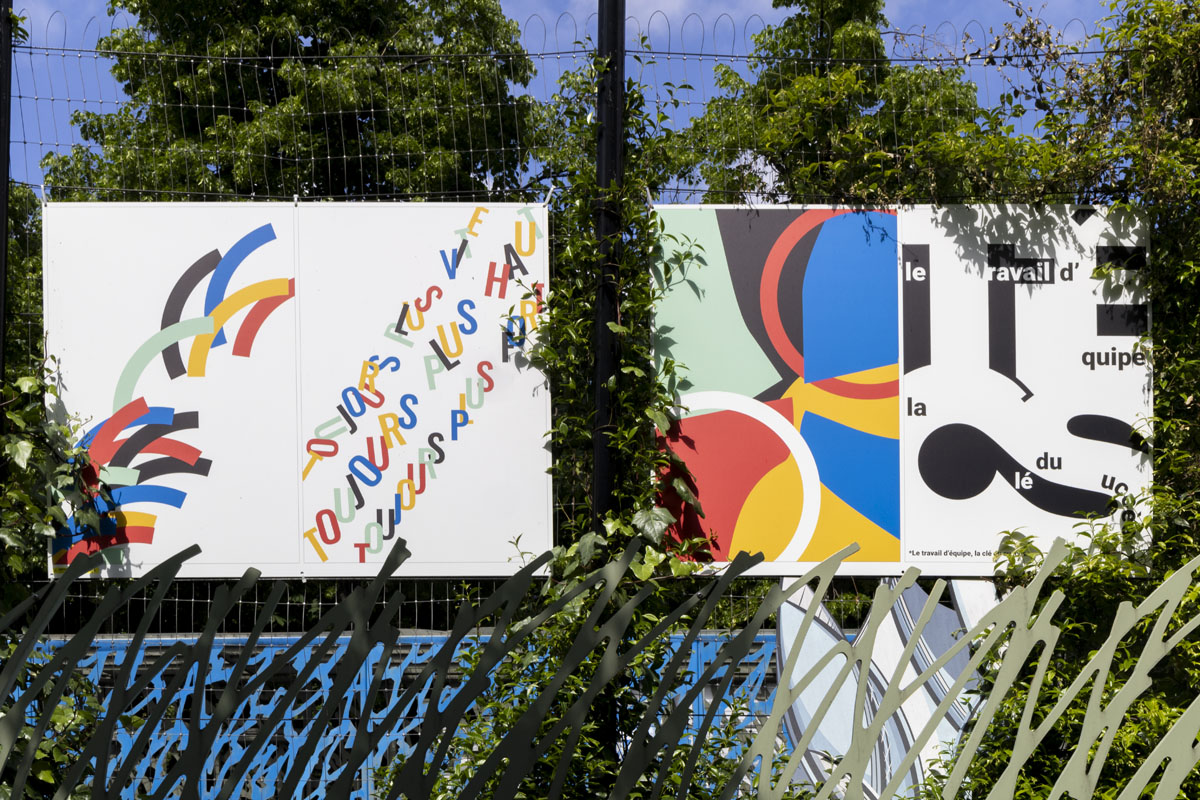
Playground, work by EPSAA students
Crédit photo :
Frederic Mauviel / Mairie de Paris

Playground, work by EPSAA students
Crédit photo :
Frederic Mauviel / Mairie de Paris
As part of the Ex-Aequo program, twelve students from EPSAA utilized their creativity and talent to enable all audiences, including all audiences, to actively participate in the Cultural Olympiad within the framework of the Olympic and Paralympic Games. The students designed graphics inspired by a grid, allowing for a thoughtful, structured, effective, and comprehensible layout using the symbols and key elements of this global sporting event. They immersed themselves in the spirit of such a significant international event, both unifying and festive. The result of their creation is displayed on the fences of the Playground des Halles (4th arrondissement).
Des bras ondulatoires, solarium at the Marie Marvingt pool (central Paris)
Artist: Eva Taulois
Work: Des bras ondulatoires, 2024. Acrylic painting.

Des bras ondulatoires, work by Eva Taulois
Crédit photo :
Collectif le réseau

Des bras ondulatoires, work by Eva Taulois
Crédit photo :
Collectif le réseau
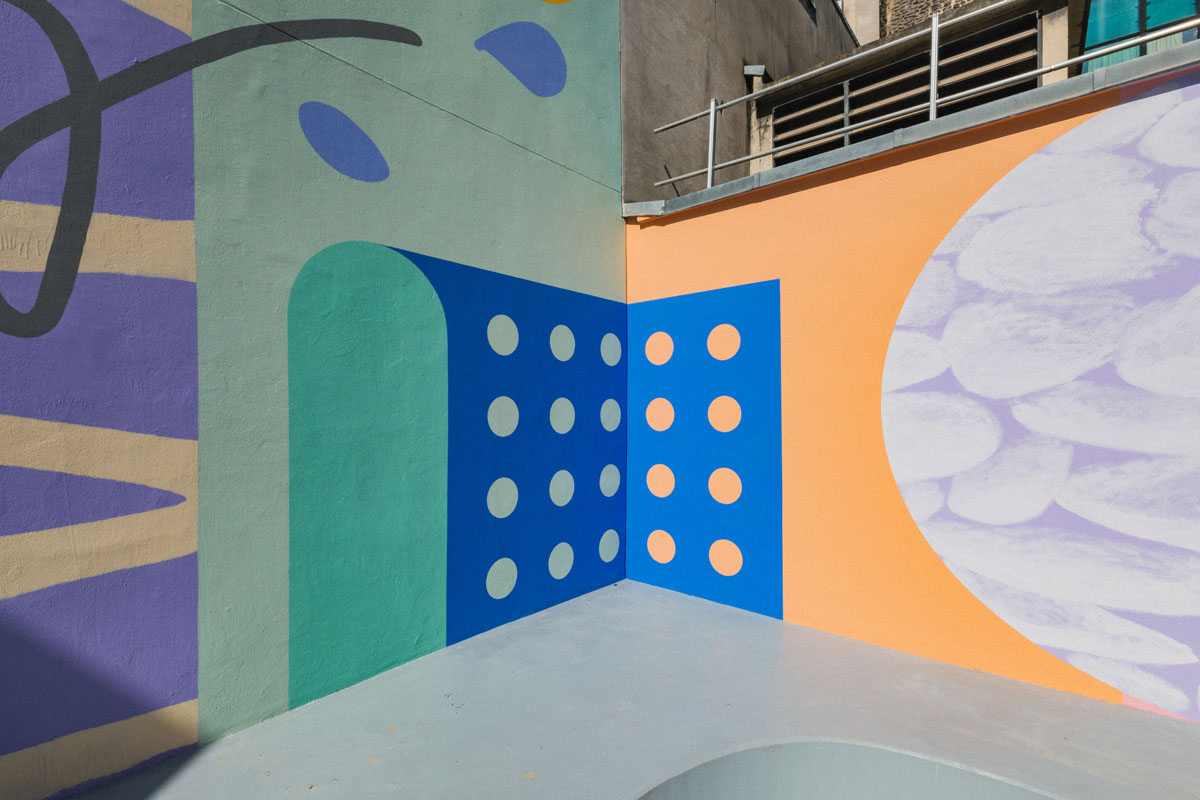
Des bras ondulatoires, work by Eva Taulois
Crédit photo :
Collectif le réseau

Des bras ondulatoires, work by Eva Taulois
Crédit photo :
Collectif le réseau
Born in 1982, Eva Taulois lives in Nantes, where she has set up her studio in a former swimming pool. Her work has been exhibited extensively in France and abroad, and can be found in public and private collections. She teaches painting at the École européenne supérieure d’art de Bretagne (Quimper site).
Eva Taulois is interested in the flexibility of materials, their capacity to adapt, to be one thing and another. Her works propose a fusion of art and life, permutating between paintings, sculptures, architecture, furniture, costumes and accessories. She proposes narratives, notably in the use of the exhibition and its fictional potential.
For the solarium of the Saint-Merri swimming pool (4th arrondissement), Eva Taulois imagined a “solar” mural. Lines structure the composition, interacting with colored shapes and surfaces in an interweaving that offers a great deal of freedom. The work evokes displacement, circulation, body movement and fluidity. There are sweeping gestures as much in swimming as in the experience of painting.
Vidéo Youtube
Official artist website : http://evataulois.net/
Access to the sports center is reserved for clubs and associations.
1–0, Gymnase Patriarches (5th arrondissement)
Artist : Valentin Guillon
Work: 1 - 0, 2024. Acrylic paint.

1-0 from Valentin Guillon
Crédit photo :
Collectif le réseau

1-0 from Valentin Guillon
Crédit photo :
Collectif le réseau

1-0 from Valentin Guillon
Crédit photo :
Collectif le réseau

1-0 from Valentin Guillon
Crédit photo :
Collectif le réseau
Born in 1993, Valentin Guillon graduated from the École Nationale Supérieure des Arts Décoratifs de Paris in 2016. His work is inspired by the world of games and sports, and takes the form of site-specific installations, monumental murals and his favorite medium, wood.
Straddling the border between abstraction and figuration, 1 - 0 is a duo of murals designed for the Patriarches gymnasium (5th arrondissement). The compositions, based on two face-to-face signs, respond to each other in both color and form. Like a dance orchestrated by the lines of the ground, the two works bring into play the body, its possible paths, and the ways in which it is included and excluded. In this way, we can see the representation of players evolving and playing in space, with movements of varying speed and intensity.
Official artist website : https://valentinguillon.com/
Access to the sports center is reserved for clubs and associations.
Les mirages de l'or, gymnase Saint-Germain (6th arrondissement)
Artist: Nathalie Talec
Artwork : Les mirages de l'or, 2024. Canvas stretched on frame, aluminum and wood, gold leaf.

Les mirages de l'or by Nathalie Talec
Crédit photo :
© Nathalie Talec ©ADAGP

Les mirages de l'or by Nathalie Talec
Crédit photo :
© Nathalie Talec ©ADAGP
Born in 1960, Nathalie Talec lives and works in Paris. After teaching sculpture from 1989 at the École des Beaux-Arts in Angoulême, then in Tours until 2013, she joined the Beaux-Arts de Paris in 2015 as head of the studio.
This monumental work aims to propose a “golden mirage” at the entrance to the Saint-Germain sports center, evoking the dynamics of a weightless body at the center of an archipelago of imaginary “geographies”. Gold is used here for its preciousness, its brilliance, its density, its relief and the vibrations it provokes at the entrance to the site. Its color is also that of victory. It becomes a vehicle for expressing man’s energy and highest aspirations.
Official artist website : https://www.nathalietalec.com/
Access to the sports center is reserved for clubs and associations.
L'entrevue, Gymnase Camou (7th arrondissement)
Artist: Coraline de Chiara
Artwork: L'entrevue, 2024. Acrylic painting.

Coraline de Chiara's l'Entrevue
Crédit photo :
Collectif le réseau

Coraline de Chiara's l'Entrevue
Crédit photo :
Collectif le réseau

Coraline de Chiara's l'Entrevue
Crédit photo :
Collectif le réseau

Coraline de Chiara's l'Entrevue
Crédit photo :
Collectif le réseau
Born in 1982 in Jakarta (Indonesia), Coraline De Chiara graduated from the École Nationale des Beaux-Arts de Paris in 2011. Winner of the LVMH Young Creators Award (2009), she has participated in numerous exhibitions (Palais de Tokyo, Paris, Musée d’Art Contemporain de Rochechouart, Palais des Beaux-Arts, Paris, among others).
Freely playing with styles and eras, Coraline enjoys introducing opposites, like a playground divided in two, all while attempting to make them work on the same plane. Stretches, gradients, layers, overlays, and masks—painting is, for her, a living illusion. Utilizing the existing windows on the gymnasium wall, the artist creates a “trompe-l’oeil’’ bay window, fringed with curtains in vibrant stripes, echoing the aesthetic of her Entrevues canvases.
An orange sun positioned above a basketball hoop dominates the scene. The scale relationship between the gymnasium’s volume and these amplified painted windows creates a sense of disorientation and invites both spectators and athletes to see between the lines.
Official artist website : https://coralinedechiara.com/
Access to the sports center is reserved for clubs and associations.
Les figurants #8 et Patère #1, Jacqueline Auriol sports center (8th arrondissement)
Artist : Jacques Julien
Works :
-
Les figurants #8, 2021. Painted wood, silicone and painted metal.
-
Patère #1, 2019-2021. Painted wood and painted metal.
-
Influenza, Rainbow warriors, 2003. Ceramic sculpture

Patère #1 1 by Jacques Julien
Crédit photo :
Frederic Mauviel / Mairie de Paris

Les figurants #8 by Jacques Julien
Crédit photo :
Frederic Mauviel / Mairie de Paris
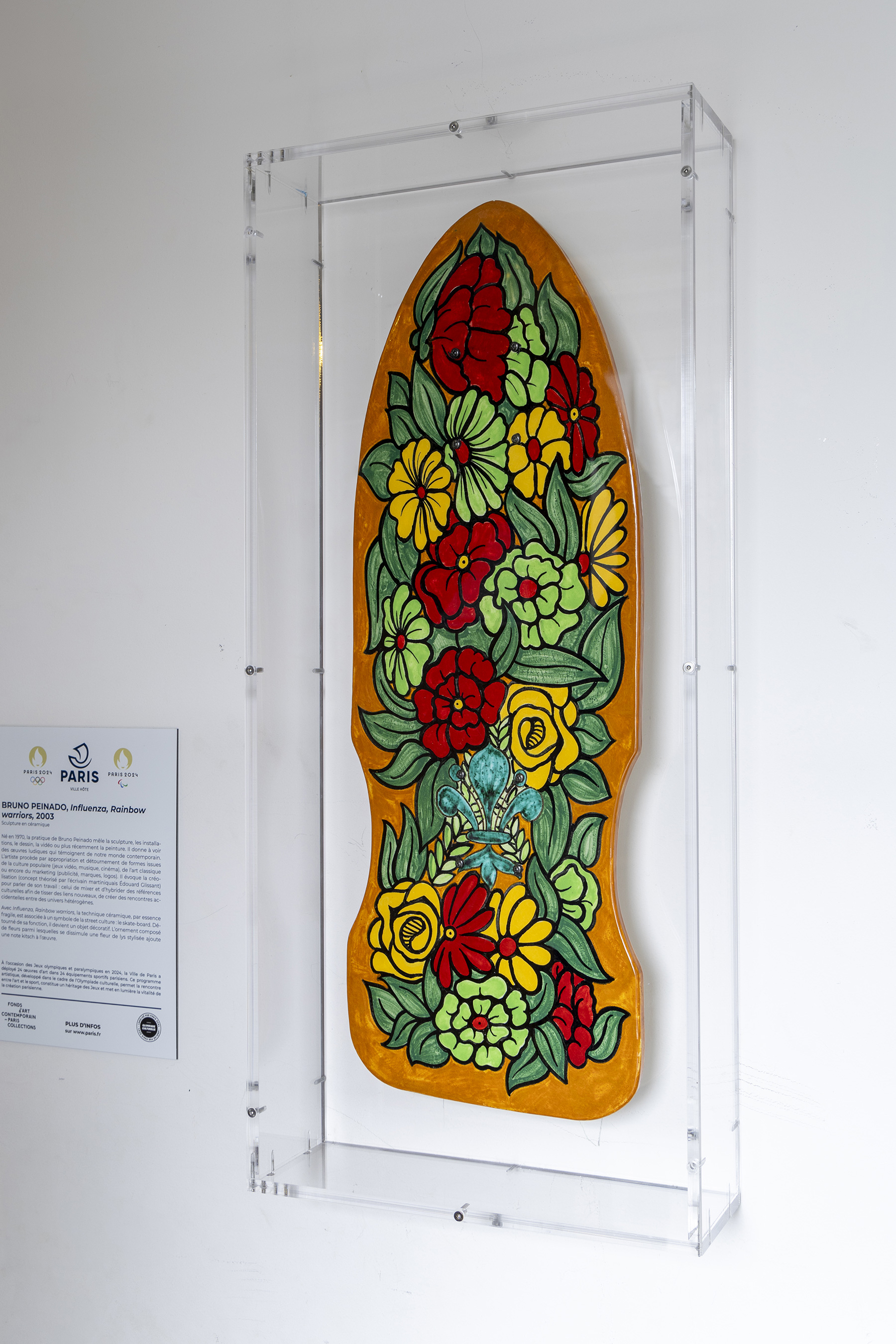
Bruno Peinado, Influenza, Rainbow warriors, 2003
Crédit photo :
Frédéric Mauviel / Ville de Paris
Born in 1967, Jacques Julien is a sculptor. A graduate of the École des Beaux-Arts de Grenoble, he works mainly through assemblage, manipulating fragments of materials or objects that make up the collection in his studio. To begin a sculpture, he starts with the materials around him, which are then modified, sanded, reshaped or painted. He works in series on several pieces at the same time.
By playing with scale and confronting materials, Jacques Julien develops poetic work tinged with humor. The artist seeks a balance, a dialogue between different materials, but also between his works. In Les Figurants #8, he plays with the codes of traditional sculpture, such as the element of the pedestal.
Patère #1 is part of a wall-mounted series. Here, Jacques Julien confronts the historical opposition between painting and sculpture, overcoming it in amalgamations of diverse objects and textures, freely evoking hybrid sporting practices.
Born in 1970, Bruno Peinado's practice combines sculpture, installations, drawing, video and, more recently, painting. His playful works bear witness to our contemporary world. The artist appropriates and diverts forms from popular culture (video games, music, cinema), classical art and marketing (advertising, brands, logos).
In Influenza, Rainbow warriors, the inherently fragile ceramic technique is associated with a symbol of street culture: the skateboard. Diverted from its original function, it becomes a decorative object. The ornament of flowers, including a stylised fleur-de-lys, adds a touch of kitsch to the piece.
Works from The Fonds d’art contemporain – Paris Collections
Access to the sports center is reserved for clubs and associations.
Lisa Ouakil
Making of Lisa-Ouakil's "Ode" at the Centre sportif Max Rousié.
Lisa Ouakil
Making of Lisa-Ouakil's "Ode" at the Centre sportif Max Rousié.
L'île aux singes, gymnase Paul Valeyre (9th arrondissement)
Artist : Antoine Carbonne
Artwork: L'île aux singes, 2024. Acrylic painting.
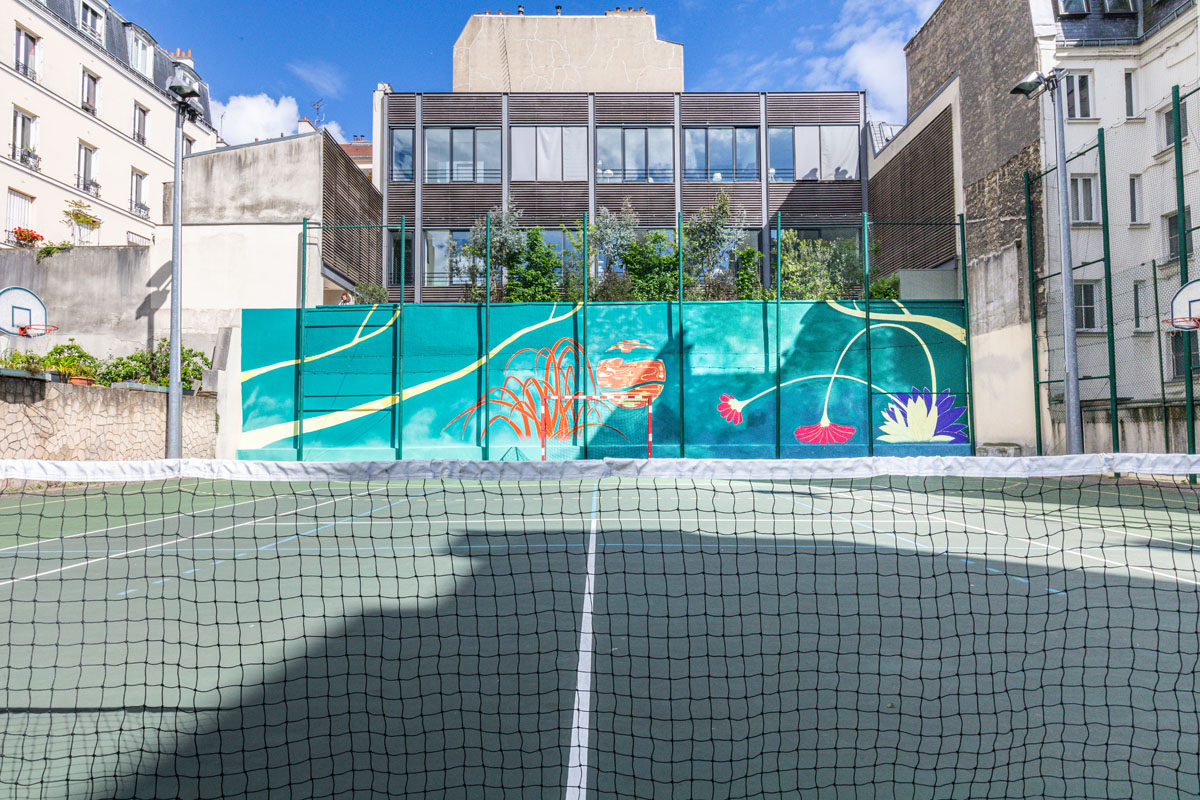
L'île aux singes by Antoine Carbonne
Crédit photo :
Collectif le réseau

L'île aux singes by Antoine Carbonne
Crédit photo :
Collectif le réseau
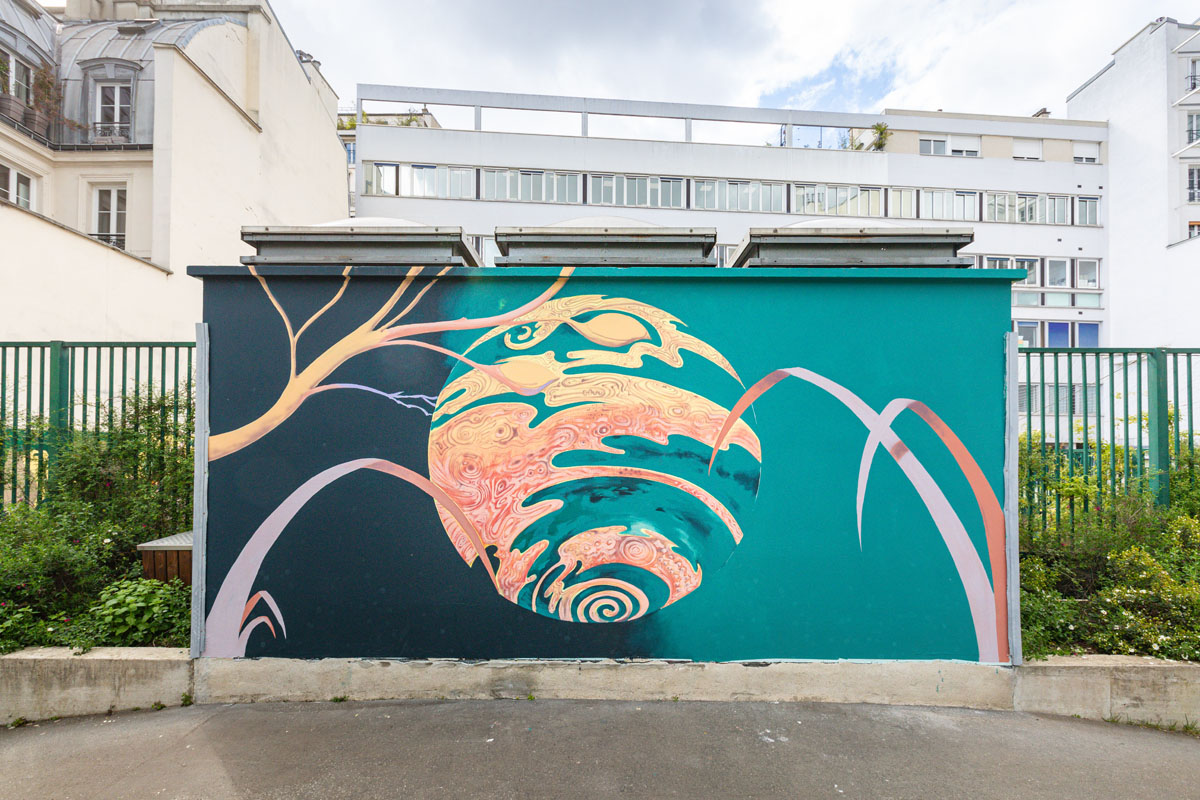
L'île aux singes by Antoine Carbonne
Crédit photo :
Collectif le réseau

L'île aux singes by Antoine Carbonne
Crédit photo :
Collectif le réseau
Born in 1987 in Paris, Antoine Carbonne graduated from the École Nationale des Beaux-Arts de Paris in 2011. He also studied at Hunter College in New York in 2010. Initially interested in comic books, he turned to painting, where he experiments with different forms of narration within a single image.
Taking the form of a “Choose Your Own Adventure” his early exhibitions represent projection spaces where everyone is free to introduce narrative tension. Large-format paintings allow for immersion into pure color landsapce.
For the Valeyre sports center (9th arrondissement), Antoine Carbonne chose to depict a world in the process of global warming. The network of plants in his two murals is inspired by slithering jungle flowers and succulent plants. These vibrant, “living” plant formations evoke a connection to vegetation found in cities or southern countries.
Access to the sports center is reserved for clubs and associations.
La lutte finale, Jean Verdier sports center (10th arrondissement)
Artist : Ivan Messac
Work: La lutte finale, 1975. Acrylic painting.

La lutte finale by Ivan Messac
Crédit photo :
Frederic Mauviel / Mairie de Paris

La lutte finale by Ivan Messac
Crédit photo :
Frederic Mauviel / Mairie de Paris

La lutte finale by Ivan Messac
Crédit photo :
Frederic Mauviel / Mairie de Paris
Born in 1948, Ivan Messac is a self-taught painter and sculptor. He is one of the leading figures in the Figuration Narrative movement, an artistic movement that emerged in the 1960s in opposition to abstraction and conceptual art. Influenced by the events of May '68, Ivan Messac does not hesitate to express his commitments in his paintings, while playing on the aesthetic codes of American pop art.
In La Lutte finale (The Final Struggle), the artist uses a colour code. Yellow represents the neutrality of the sporting theme, while blue evokes the player's dependence on a club. Finally, red expresses victory, liberation and, by extension, combat; the motif of the fist has already been exploited by the artist in Noble Art (1973), a series of paintings devoted to boxing players that underpins an analogy between artist and athlete.
Work from the Fonds d’art contemporain – Paris Collections
Access to the sports center is reserved for clubs and associations.
Le reflet dans les airs, Gymnase Château Landon (10th arrondissement)
Artist: Lassana Sarre
Work: Le reflet dans les airs, 2024. Acrylic painting.

Lassana Sarre's Le reflet dans les airs
Crédit photo :
Collectif le réseau

Lassana Sarre's Le reflet dans les airs
Crédit photo :
Collectif le réseau

Lassana Sarre's Le reflet dans les airs
Crédit photo :
Collectif le réseau

Lassana Sarre's Le reflet dans les airs
Crédit photo :
Collectif le réseau
Born in 1994, Lassana Sarre lives in Paris. A visual artist and painter, he is a graduate of the Villa Arson in Nice. Inspired by his family environment—and in particular the town where he grew up, Vitry-sur-Seine—as well as by colonial and contemporary issues, his works depict both close friends and historical figures. In his often large-format canvases, layers and sub-layers are apparent, testifying to the progress of an idea, an action in the making. His historical, cultural and social identities lead him to push back the boundaries of painting, creating scenes whose disproportion grabs our attention.
For the Château-Landon gymnasium (10th arrondissement), Lassana Sarre chose to depict legendary athlete Maryse Éwanjé-Épée. Between 1983 and 2007, she held the French high jump record, clearing the 1.96-meter bar. Between heaven and earth, Lassana Sarre shows us two silhouettes, those of Maryse and her reflection, soaring in a movement full of power and grace, and invites future generations to aim ever higher, in sport as in life.
Effervescence, Cour des Lions swimming pool (11th arrondissement)
Artists: Sibylle Esposito, Judith Henry (École Boulle), Céane Jelsch, Laurine Navet (École Estienne)
Work: Effervescence, 2024. Vitrophanies.

Prototype of the work Effervescence
Crédit photo :
Sibylle Esposito, Judith Henry, Céane Jelsh et Laurine Navet
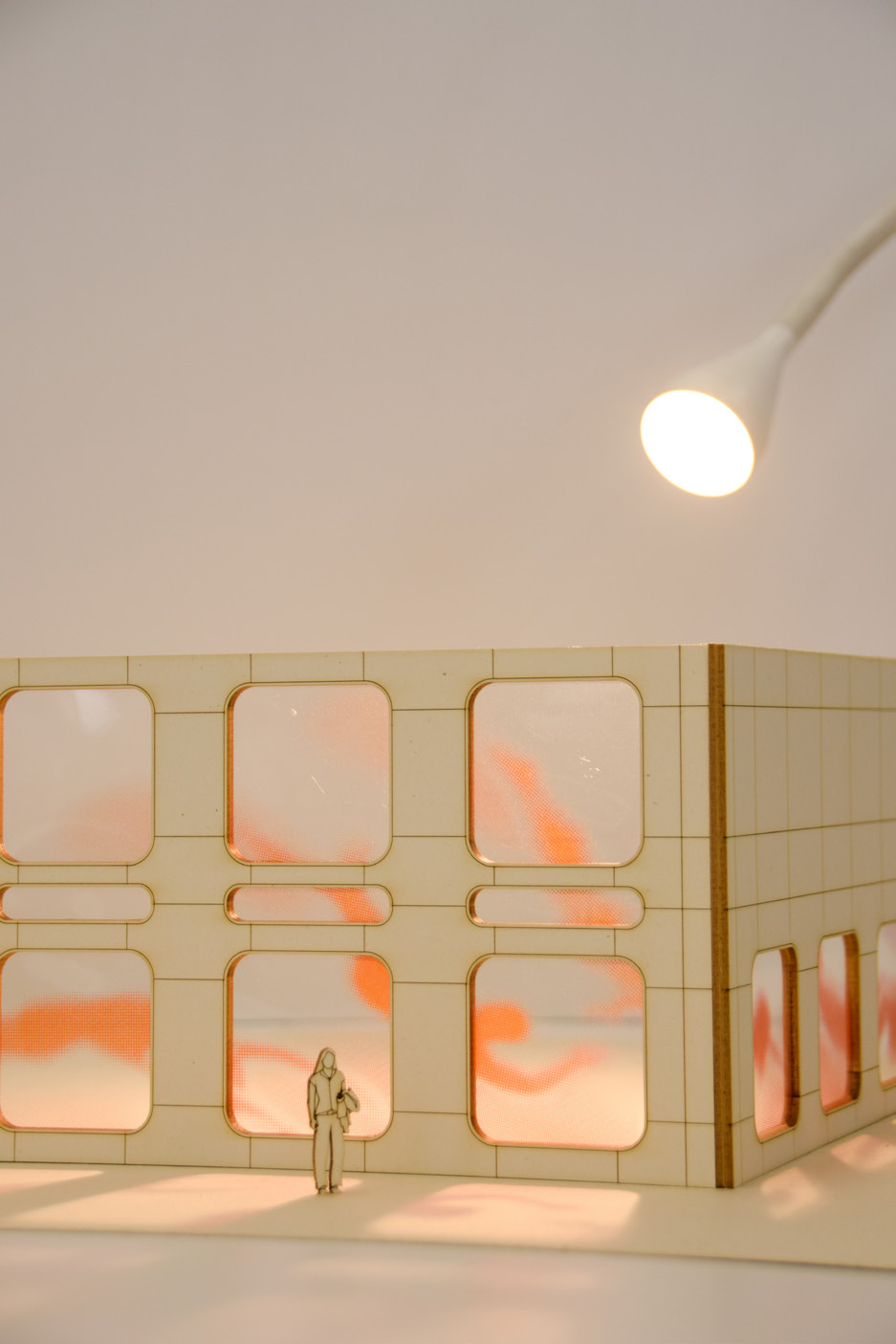
Prototype of the work Effervescence
Crédit photo :
Sibylle Esposito, Judith Henry, Céane Jelsh et Laurine Navet
The Effervescence project is a graphic work installed as a “vitrophanie” (decorative sticker) on the façade of the Cour des Lions swimming pool (11th arrondissement). This artistic creation, representing the movement and undulation of the body, swimming and water, enlivens the building’s regular windows. From the street, you can see the fresco unfolding across all the ground-floor windows on both sides of the pool.
It appears abstract when up-close up, evoking the movement of water, but the composition takes on its full meaning when viewed from a distance, revealing silhouettes stretching over several metres. The intervention is completed by a digital animation that brings the work to life. The dynamics of swimming and the movement of passers-by in front of the fresco are highlighted.
This project is the result of a partnership between the École Boulle and the École Estienne, with the support of the Bureau du Design, de la Mode et des Métiers d’Art de la Ville de Paris.
Boïngs & Bams (the colors of the Big Bang), gymnase Fontaine-au-Roi (11th arrondissement)
Artist: Florian Viel
Work: Boïngs & Bams (the colors of the Big Bang), 2024. Acrylic paint.

Boïngs & Bams (the colors of the Big Bang) by Florian Viel
Crédit photo :
Collectif le réseau
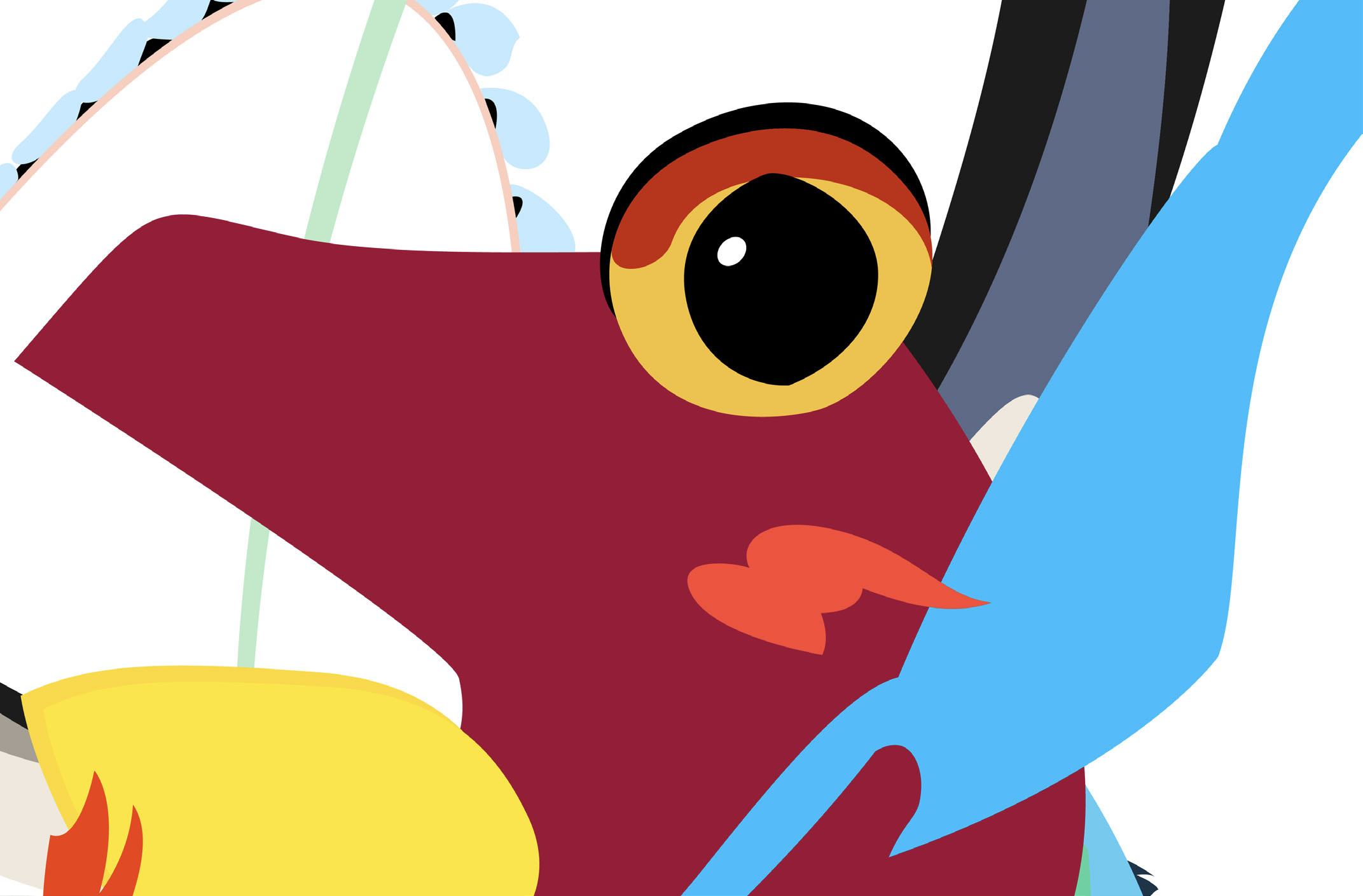
Boïngs & Bams (the colors of the Big Bang) by Florian Viel
Crédit photo :
Collectif le réseau
Born in 1990, Florian Viel lives and works in Paris. Graduate of the Beaux-Arts de Paris with a thesis on the emergence of plants in art, Florian Viel questions the Western view of the Tropics. With clichés and fantasies of an enchanted elsewhere, he thwarts our stereotypic notions of the tropical world by creating a bright and colorful universe that combines the figurative with the abstract.
Inspired by the dynamics and captivity of the Fontaine du Roi sports center, Florian Viel designed an elaborate mural for their reception hall. The echo of bouncing balls, the clamor of referee calls, the athletes’ sighs of relief after their effort… onomatopoeic sounds that the artist transcribes into his piece, revealing their artistry: «a concentration of energy so strong that it resonates to the farthest reaches of the Universe». Drawn from breathtaking flora and fauna, the motifs in his work take the shape of chimeras emerging following the explosion of the Big Bang, who, like athletes in training, are preparing for the feats to come.
Access to the sports center is reserved for clubs and associations.
Les Grimpeurs libres, gymnase Léon Mottot (12th arrondissement)
Artist: Epsylon Point
Work: Les Grimpeurs libres, circa 1990. Spray paint on canvas.

Les Grimpeurs libres of Epsylon Point
Crédit photo :
Frederic Mauviel / Mairie de Paris
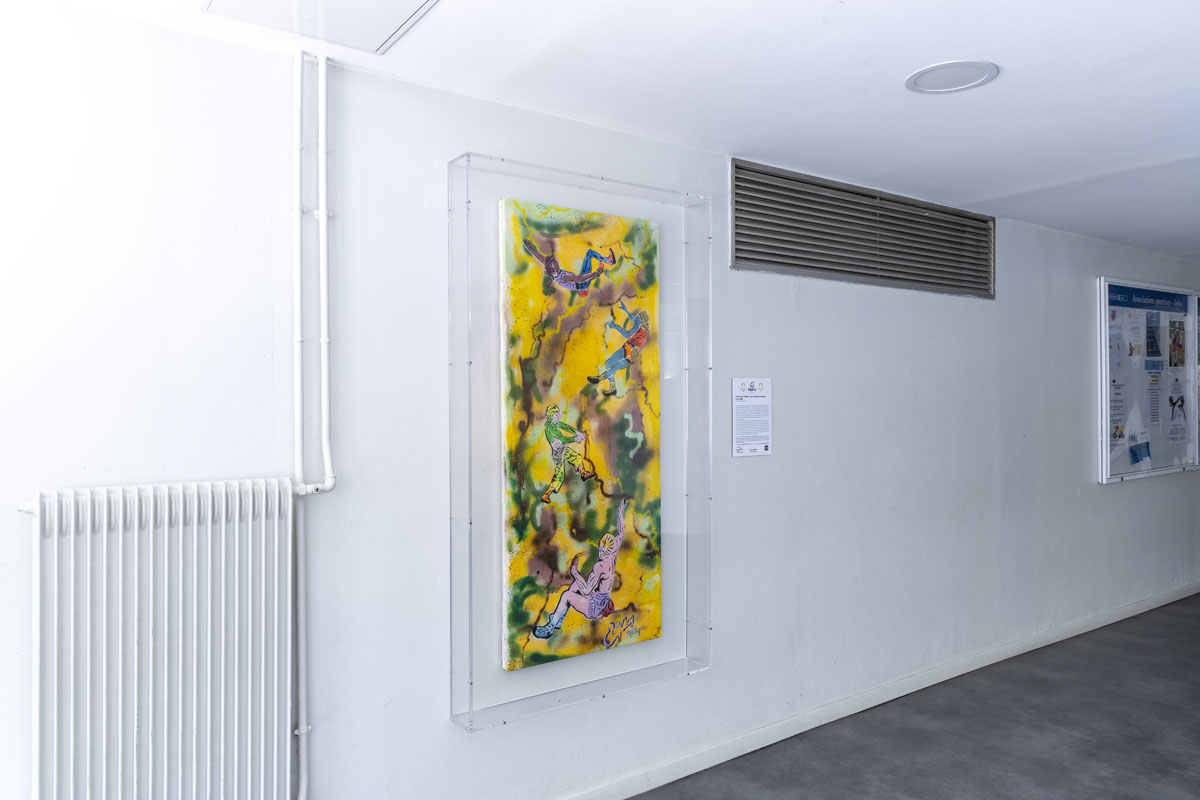
Les Grimpeurs libres of Epsylon Point
Crédit photo :
Frederic Mauviel / Mairie de Paris

Les Grimpeurs libres of Epsylon Pointgrimp
Crédit photo :
Frederic Mauviel / Mairie de Paris
Born in 1950, Epsylon Point is a pioneer of urban art in France. He produced his first graffiti in the late 1970s, then developed a practice of stencilling in color from 1983 onwards in the Balard district of Paris. He took part in the first gathering of "graffitistes" organized by the VLP (Vive La Peinture) collective, alongside artists such as Miss.Tic, Speedy Graphito, Blek le Rat, Jef Aérosol and Futura 2000. His work deals with social and political issues, but also draws on sporting practices such as climbing, circus and kung fu.
The work Les Grimpeurs libres was created using reused materials: Epsylon Point recovers canvases and makes its own frames. The abstract background, created by variations in pressure, features climbing figures, including champion Patrick Edlinger. The artist experiments with the material effects produced by spray paint cans: the formation of bubbles, the repulsive effect of paints, cracks and drips. The acidic hues and dynamic figures evoke the sensations of freedom and adrenalin that come with free climbing.
Work from the Fonds d’art contemporain – Paris Collections
Access to the sports center is reserved for clubs and associations.
Espaces de jeux, gymnase Reuilly and Jean Boiteux swimming pool (12th arrondissement)
Artist: Kahina Loumi
Work : Espaces de jeux, 2024. Mural painting and vitrophanie.

Espaces de jeux by Kahina Loumi
Crédit photo :
Collectif le réseau

Espaces de jeux by Kahina Loumi
Crédit photo :
Collectif le réseau

Espaces de jeux by Kahina Loumi
Crédit photo :
Collectif le réseau

Espaces de jeux by Kahina Loumi
Crédit photo :
Collectif le réseau
Born in Paris in 1982, Kahina Loumi graduated from the École Européenne Supérieure d’Art de Bretagne in 2018. Fascinated by the beauty of natural landscapes, her resolutely optimistic painting seeks to combine colors and shapes to create paths that extend beyond the surface of the canvas. The subtle hues she employs in her paintings, often diluted over a long period of time, are conducive to transparency and changing atmospheres.
The main subject of the two-part work the artist created for the Reuilly sports center and Jean Boiteux swimming pool, color transforms the large glass slats into an imaginary playground, facing an abstract waterscape. Playing on the limpidity and opacity of the surfaces, she creates an impression of lightness through a set of shapes that seem to float freely. This silent, contemplative abstract dialogue harmonizes the vibrations of colored spaces with the quiet strength of athletic perseverance.
Official artist website : https://www.kahinaloumi.com/
Salia, Auguste Blanqui sports center (13th arrondissement)
Artiste: Melika Shafahi
Work: Salia, Rapproche/Closer series, 2019. Photography.

Salia de Melika Shafahi
Crédit photo :
Frederic Mauviel / Mairie de Paris

Salia de Melika Shafahi
Crédit photo :
Frederic Mauviel / Mairie de Paris

Salia de Melika Shafahi
Crédit photo :
Frederic Mauviel / Mairie de Paris
Born in 1984, Melika Shafahi is a photographer with degrees from Tehran University of Art and the Ecole Nationale Supérieure des Beaux-Arts de Lyon. She is interested in socio-cultural mixing and the relationship between individuals and territories.
For her Rapproche / Closer series, the artist spent several months at Marseille’s Friche la Belle de Mai. After making friends with some of the young people who frequent the area, she had them pose with accessories she had chosen: deceptively luxurious drapes found at flea markets and a photograph by Torbjørn Rødland downloaded from the Internet. The artist highlights the way in which the young people of Generation Z stage themselves.
The works in this series are conceived as a image file that can be printed and stuck to the wall, then torn up and endlessly renewed.
Work from the Fonds d’art contemporain – Paris Collections
LANNO, Charles Moureu sports center (13th arrondissement)
Artist : Sénéquier DesignClub
Artwork: LANNO, 2024. Patinated steel.

Prototype of the LANNO work by Sénéquier DesignClub
Crédit photo :
Jean-Baptiste Sénéquier
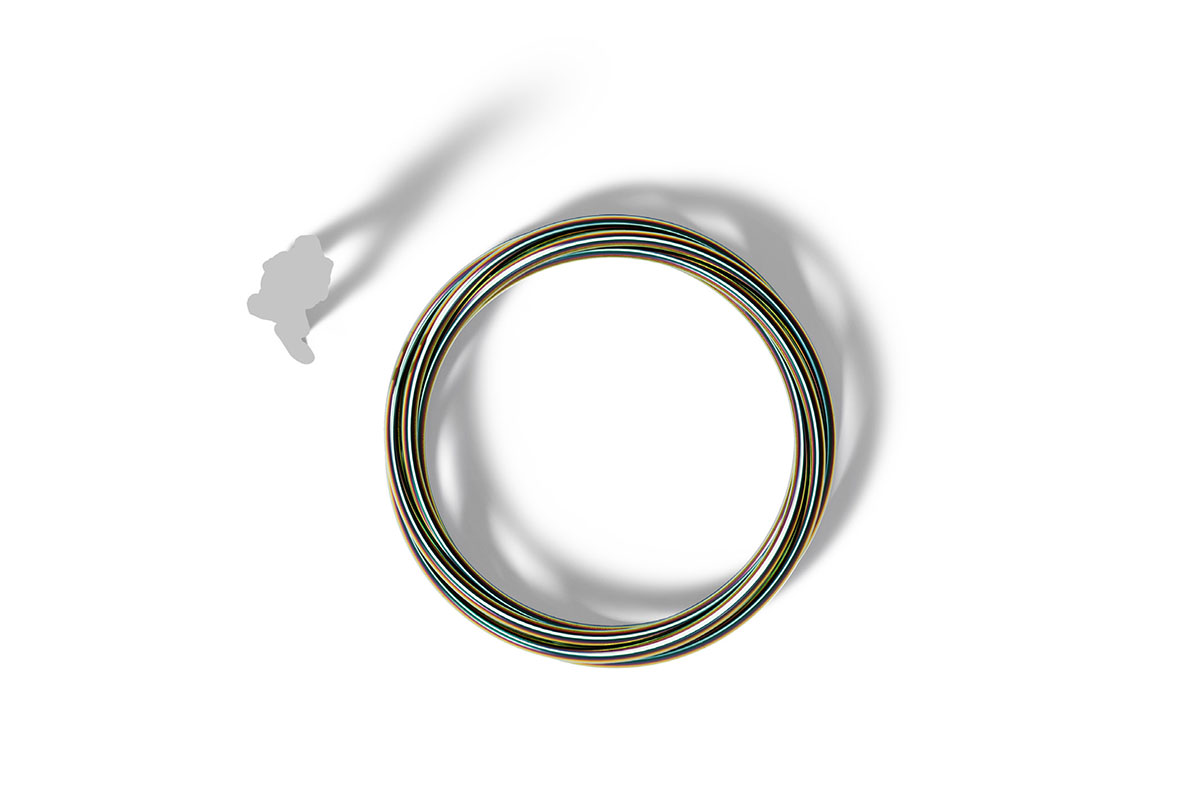
Prototype of the LANNO work by Sénéquier DesignClub
Crédit photo :
Jean-Baptiste Sénéquier
Sénéquier is a multi-disciplinary design agency based in Paris, which seeks to fuse pragmatism and exploration to reinvent the links between craft and industry. Its approach lies in the ability to give meaning to projects by anchoring them in their local context and time.
He presents LANNO, a bench that embodies the philosophy of the Olympic Games, symbolizing the union of cultures through its five iridescent steel tubes.
Reinterpreting the Olympic rings as a single, distinct circle of intertwining colors, this installation embodies the idea that harmony is born of diversity, and that inclusion is essential to our common future.
2SHY
Making of 2SHY's "Épinettes tropicales" mural at the Fragonard gymnasium (17th arrondissement)
2SHY
Making of 2SHY's "Épinettes tropicales" mural at the Fragonard gymnasium (17th arrondissement)
L'envol, Elisabeth sports center (14th arrondissement)
Artist: Claude Blo Ricci
Work: L'envol, 2024. Acrylic painting.

L'envol of Claude Blo Ricci
Crédit photo :
Frederic Mauviel / Mairie de Paris

L'envol of Claude Blo Ricci
Crédit photo :
Frederic Mauviel / Mairie de Paris

L'envol of Claude Blo Ricci
Crédit photo :
Frederic Mauviel / Mairie de Paris

L'envol of Claude Blo Ricci
Crédit photo :
Frederic Mauviel / Mairie de Paris
Born in 1982 in Lyon, Claude Blo Ricci pursued scientific studies then moved to graphic design before dedicating himself entirely to painting and drawing, disciplines he has engaged with throughout his life. Although rooted in traditional graffiti in terms of materials and composition, his practice demonstrates a keen sense of context to question the immediate environment and offer a parallel vision.
Tinged with surrealism, his paintings hybridize figuration and abstraction, drawing and improvisation, to transcribe remnants of thought onto the canvas. Here, using the base running along the gymnasium, the artist creates a composition inspired by a collage aligned with the main entrance.
The mural depicts a figure leaping into an abstract landscape, structured by shapes, colors, and textures that evoke an external world. The line accentuates the outburst, echoing the athlete’s self-transcendence, reinforcing the dynamic of the athlete’s virtuosic movement, and further highlighting the grace of the body in motion.
Access to the sports center is reserved for clubs and associations.
Lier les sports, Jules Noël sports center (14th district)
Artist: Mathilde Gullaud and Jérôme Foubert (Studio Majeur)
Artwork: Lier les sports, 2024. Digitally machined and screen-printed aluminum.

Lier les sports by Mathilde Gullaud and Jérôme Foubert
Crédit photo :
Frederic Mauviel / Mairie de Paris

Lier les sports by Mathilde Gullaud and Jérôme Foubert
Crédit photo :
Frederic Mauviel / Mairie de Paris
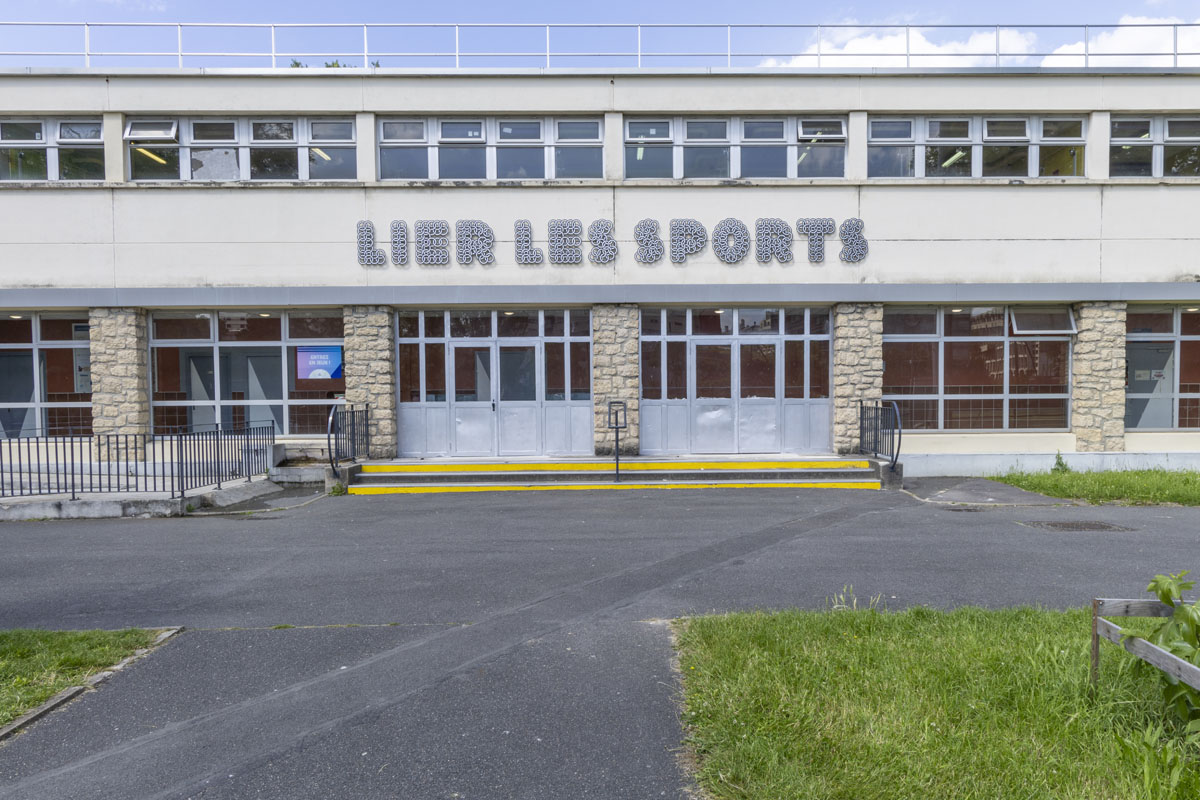
Lier les sports by Mathilde Gullaud and Jérôme Foubert
Crédit photo :
Frederic Mauviel / Mairie de Paris
The Olympic Games are a sporting objective, a celebration of art and a shared motivation. With this in mind, designer and scenographer Mathilde Gullaud and graphic artist Jérôme Foubert teamed up to create a symbolic work of art for the Jules Noël sports center in Paris’s 14th arrondissement.
Their project takes the form of the phrase “LIER LES SPORTS” (Linking sports), cut from aluminum and placed on the façade for all to see. A direct reference to these notions of link, inclusion and communion, its design is based on the Olympic rings as a motif, a manifest heritage of the Games and a representation of the five continents united by Olympism.
For the occasion, a “revival” of a Jean Larcher typeface from the 70s was created. The rings were redesigned and then silk-screened, creating a three-dimensional graphic effect that plays between mattness and brilliance. In this way, the interlacing reinforces the idea of solidarity and union characteristic of the sports mentality.
Parade sportive, gymnase de la Croix-Nivert (15th arrondissement)
Artists: École Duperré, Angèle BASILE, Pierre BOUNHOURE, Sarah BOUYSSOU, Mailine CHAN, Sevia CHENUT ARDOUIN, Maxime DAVID, Chloé FERNANDES, Loïse HULIN, Mona LEMAIRE, Raphael MICHEL, Jules POUTIER, Côme SCIALOM, Robin TUBEUF, with the participation of students from DNMADE, espace mention scénographie et évènementiel.
Work: Parade sportive, 2024. Photographs.

Parade sportive by students from Duperré school
Crédit photo :
Frédéric Mauviel / Mairie de Paris

Parade sportive by students from Duperré school
Crédit photo :
Frédéric Mauviel / Mairie de Paris

Parade sportive by students from Duperré school
Crédit photo :
Frédéric Mauviel / Mairie de Paris

Parade sportive by students from Duperré schoolpara
Crédit photo :
Frédéric Mauviel / Mairie de Paris
Sport exalts bodies in terms of endurance and power, performance and competitiveness, but also self-care and self-centeredness. The sports body is fashionable: between constraint and liberation, success and defeat, tension and conquest, it constitutes a contemporary ideal of expression.
The Parade Sportive project, presented in the Croix-Nivert gymnasium (15th arrondissement), is a photographic series by students in the Advanced Diploma in Applied Arts in Fashion, major Image Média Éditorial, at École Duperré. The series unfolds as a stylized collection of characters, each at the crossroads of several sports, which they hybridize in a burlesque universe of assertive fantasy.
Faced with the injunctions that structure the sports body, the students wanted to develop an offbeat, humorous and open approach. This carnivalesque sports parade punctuates the space of the Croix Nivert gymnasium: eccentric gods and goddesses in large format, with a playful, benevolent presence.
Access to the sports center is reserved for clubs and associations.
Untitled (THE WAY OUT IS IN…), Pierre de Coubertin stadium (16th arrondissement)
Artist: Rero
Work: Untitled (THE WAY OUT IS IN…), 2022. Cut and burned wood.

The way out is in de Rero
Crédit photo :
Frédéric Mauviel / Mairie de Paris

The way out is in de Rero
Crédit photo :
Frédéric Mauviel / Mairie de Paris

The way out is in de Rero
Crédit photo :
Frédéric Mauviel / Mairie de Paris

The way out is in de Rero
Crédit photo :
Frédéric Mauviel / Mairie de Paris
Born in Nancy in 1983, RERO is an artist whose work combines urban art, sculpture and painting to create works that challenge social and cultural conventions. His work THE WAY OUT IS IN was created in 2022 for the exhibition “Capitales, 60 ans d’art urbain à Paris”, at the Hôtel de Ville de Paris.
RERO’s work lies halfway between urban art and conceptual art. The artist questions the art world on the one hand, and image codes and intellectual property on the other, through an acronym that appears regularly in his work: WYSIWYG - What You See Is What You Get. Hijacking and self-censorship are the watchwords of his research into the negation of the image: he systematically crosses out his messages with a thick black line.
Deeply imbued with philosophy and sociology, he never ceases to question the codes of our society. He is particularly interested in the notions of consumption and obsolescence, never judging, but proposing that the public do so. The artist questions the limits of intimacy with what we make public, voluntarily or involuntarily, consciously or unconsciously, notably on the Internet.
Access to the sports center is reserved for clubs and associations.
Épinettes tropicales, gymnase Fragonard (17th arrondissement)
Artist : 2SHY
Work : Épinettes tropicales, 2023. Mural painting.

Épinettes tropicales from 2SHY
Crédit photo :
Collectif le réseau

Épinettes tropicales from 2SHY
Crédit photo :
Frédéric Mauviel / Mairie de Paris

Épinettes tropicales from 2SHY
Crédit photo :
Collectif le réseau

Tropical spruce from 2SHY
Crédit photo :
Collectif le réseau
Born in 1976, 2SHY is a graphic designer and visual artist living and working in Paris. A self-taught artist, 2SHY explores various visual languages in his works, comprising illustrations, graphic designs, and hand-drawn typography.
As part of the Ex-Aequo program, the artist takes over the side wall of the Fragonard sports center (17th arrondissement) creating an intricate construction game where geometric figures in bright colors stand out and create an impression of openness that highlights the building’s features. Staying true to his artistic approach, 2SHY presents a vibrant, dynamic, and colorful composition that is instantly recognizable.
Official artist website : https://2shywashere.com/
Ode, Max Rousié sports center (17th arrondissement)
Artist: Lisa Ouakil
Work: Ode, 2024. Mural painting.

Ode by Lisa Ouakil
Crédit photo :
Collectif le réseau

Ode by Lisa Ouakil
Crédit photo :
Collectif le réseau

Ode by Lisa Ouakil
Crédit photo :
Collectif le réseau

Ode by Lisa Ouakil
Crédit photo :
Collectif le réseau
Born in 1993, Lisa Ouakil lives in Paris. A 2017 graduate of the École Nationale Supérieure d’Arts de Paris-Cergy, her work revolves mainly around painting, while also focusing on ceramics, writing and music. The analogy between pictorial material and flesh, the rapprochement and fragmentation of the body and landscape, and a particular attention to color and contrast are the main driving forces behind her work. For her, the plastic form must provoke a sensation, imprisoning a moving, organic form.
For the Max Rousié sports center (17th arrondissement), Lisa Ouakil took over the four sides of a modular building to develop an architectural movement. The three walls visible from the stadium, united in a single colored background, form a monumental frieze: a visual dynamic of bodies whose common momentum ultimately unites them. On the opposite side, the back of the stadium features an uncertain shape against an orange background, illuminating the surrounding space by contrast. While borrowing her silhouettes from sports imagery, the artist gives pride of place to color, its poetry and vibrancy in the public space.psy
Official artist website : https://lisaouakil.wixsite.com/lisa-ouakil
Access to the sports center is reserved for clubs and associations.
Sans titre, Bertrand Dauvin sports center (18th arrondissement)
Artist: Psyckoze
Work: Sans titre, 2022. Aerosol paint.

Sans titre by Psyckoze
Crédit photo :
Frédéric Mauviel / Mairie de Paris

Sans titre by Psyckoze
Crédit photo :
Frédé

Sans titre by Psyckoze
Crédit photo :
Frédéric Mauviel / Mairie de Paris
Born in 1969, Psyckoze is one of the precursors and pioneers of graffiti culture in France. His works can be seen all over the world, notably in the catacombs of Paris.
His work “Sans Titre” ("Untitled") was created in 2022 for the “Capitales, 60 ans d’art urbain à Paris” exhibition at the Hôtel de Ville de Paris. Psyckoze began graffiti izloty
n 1984 at the age of 15. In 1987, he adopted his pseudonym to reflect the attacks perpetrated in Paris by Action Directe from 1979 to 1987.
Parallel to his work on the streets of Paris, he also developed his interventions under the city, in the quarries and catacombs of Paris, of which he became the most fervent explorer and defender. In this space outside time and the constraints of society, he pursues a timeless approach based on the trace and the ambition that urban works survive his generation.
Access to the sports center is reserved for clubs and associations.
Éphémères, Bertrand Dauvin sports center (18th arrondissement)
Artiste: Zlotykamien
Work : Éphémère, 2022. Aerosol paint.

Zlotykamien Éphémère
Crédit photo :
Frédéric Mauviel / Mairie de Paris

Zlotykamien Éphémère
Crédit photo :
Frédéric Mauviel / Mairie de Paris

Zlotykamien Éphémère
Crédit photo :
Frédéric Mauviel / Mairie de Paris
Born in Paris in 1940, Gérard Zlotykamien was the first artist to make the street his playground, painting on palisades, decrepit walls and places in transition destined for destruction. His work Éphémères was created in 2022 for the “Capitales, 60 ans d’art urbain à Paris” exhibition at Paris City Hall.
In the early 1970s, in a capital undergoing reconfiguration, the Les Halles construction site was a field of exploration for artists. Gérard Zlotykamien spray-painted ethereal silhouettes, alone or in groups, on the palisades of Les Halles, inheriting the forms of Calder and Miró. Right from the start of this artist’s work, there’s a whole aesthetic construction emanating from a very intimate path.
Access to the sports center is reserved for clubs and associations.
Le sport ensemble !, Jules Ladoumègue sports center (19th arrondissement)
Artist: Collectif ABOUT A WORKER
Artwork: Le sport ensemble, 2024. Collages on textile panels.

Le sport ensemble! by the ABOUT A WORKER collective
Crédit photo :
Frédéric Mauviel / Mairie de Paris

Le sport ensemble! by the ABOUT A WORKER collective
Crédit photo :
Frédéric Mauviel / Mairie de Paris

Le sport ensemble! by the ABOUT A WORKER collective
Crédit photo :
Frédéric Mauviel / Mairie de Paris

Le sport ensemble! by the ABOUT A WORKER collective
Crédit photo :
Frédéric Mauviel / Mairie de Paris
The studio ABOUT A WORKER was founded in 2017 with the aim of transforming social connections through the arts and the transmission of textile know-how. The studio views creation as a universal language and a means of fostering social bonds. It provides various communities with the artistic tools to become expressive designers. Through inclusive workshops based on knowledge sharing and environmental responsibility, ABOUT A WORKER initiates a dialogue about socio-professional realities.
As part of the Cultural Olympiad, ABOUT A WORKER led the creation of collective textile murals to adorn the Jules Ladoumègue Sports Center (19th arrondissement). The project’s goal was to enable the center’s athletes to showcase their physical practice in the form of a communal artwork. During workshops, around a hundred participants illustrated their vision of play and movement by producing geometric collages. These motifs were then reinterpreted by the studio to create the textile murals in their Parisian workshop using surplus fabrics.
Super Pouvoirs, Maryse Hilsz sports center (20th arrondissement)
Artist: Chloé Dugit Gros
Work: Super pouvoir, 2024. Mural painting.

Super pouvoirs by Chloé Dugit-Gros
Crédit photo :
Collectif Le Réseau
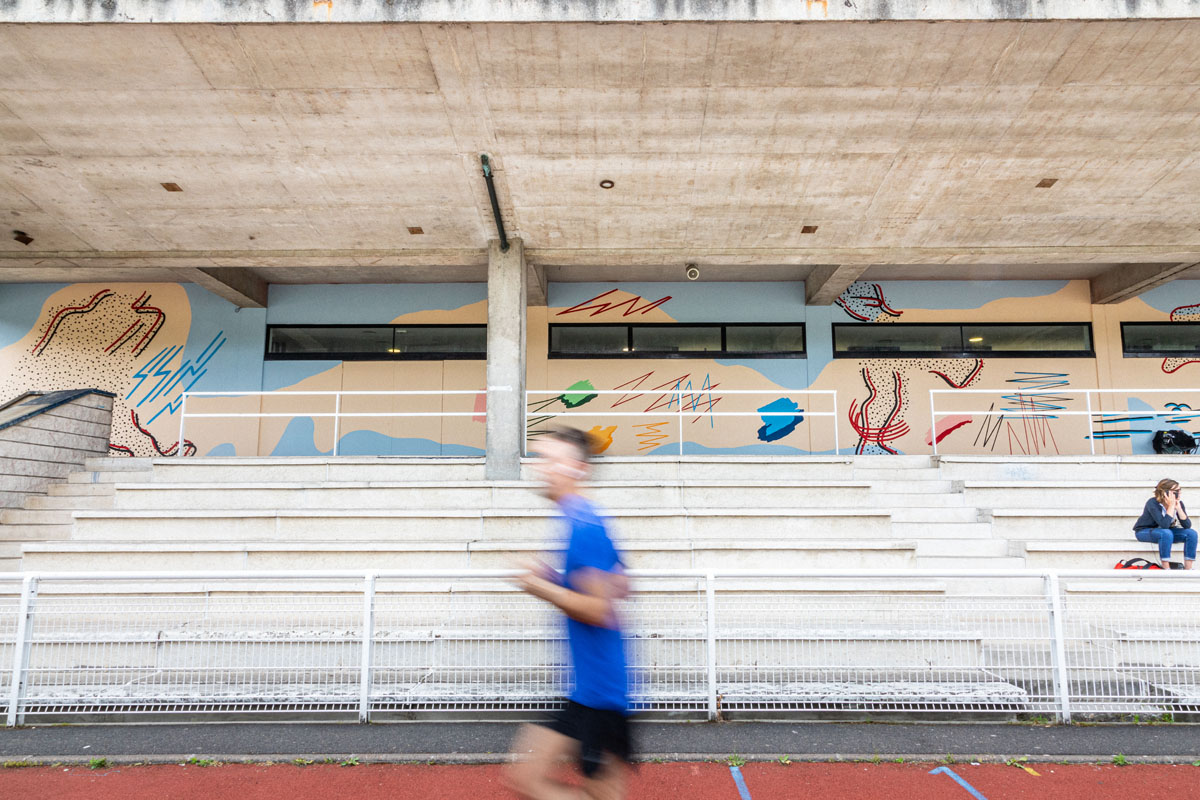
Super pouvoirs by Chloé Dugit-Gros
Crédit photo :
Collectif le Réseau
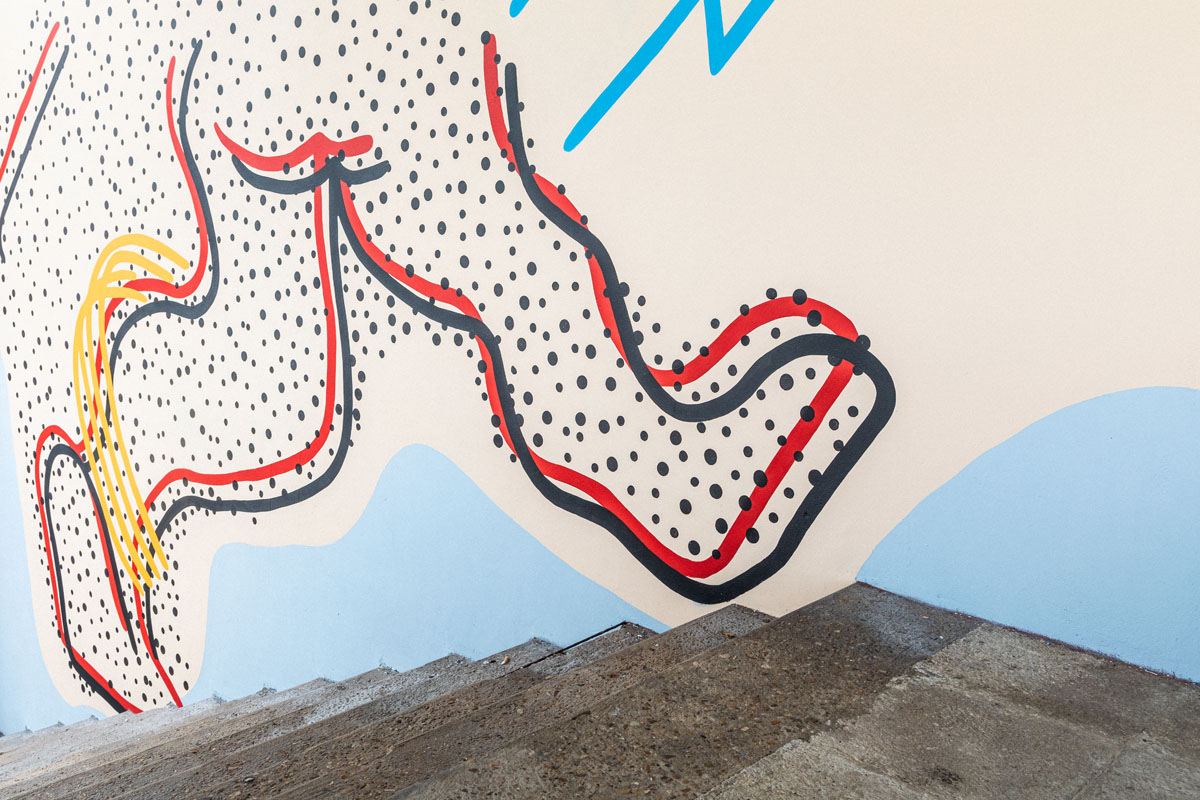
Super pouvoirs by Chloé Dugit-Gros
Crédit photo :
Collectif Le Réseau

Super pouvoirs by Chloé Dugit-Gros
Crédit photo :
Collectif Le Réseau
Born in Paris in 1981, Chloé Dugit-Gros graduated from the École Nationale Supérieure des Beaux-Arts de Paris. Her work takes on hybrid forms blurring boundaries between disciplines to explore the edges of design, fine arts, and decorative arts. She creates joyful and colorful objects, installations, videos, and performances, constantly adopting new techniques—from handcrafted tufted wool tapestries to wrought iron, children’s furniture, and monumental mural painting.
For the Maryse Hilsz sports center (20th arrondissement), Chloé Dugit-Gros unveils a vast composition along the stadium bleachers. The story unfolds like a comic strip, from left to right, fully visible from the football field. A character in action stands out, whose movements decompose and stretch throughout the drawing.
In this fiction that allows for changes in scale, the ball metamorphoses into an abstract shape, a soft material, and a comet. Limitless, imagination embraces all possibility.
Official artist website : https://www.chloedugit-gros.com/
Access to the sports center is reserved for clubs and associations.
Esprit d’équipe, Louis Lumière sports center (20th arrondissement)
Artists : EPSAA students (Calixte Dugelay, Claire Duprat, Mina Givre, Tracy Claireville, Adèle Guy, Céline Jang, Lisa Laffay, Elenitsa Neveu,Adrien Oxaran, Alice Privat de Fresseney, Alice Riffaut, Félix Thiry, Lily Vaudequin, Carla Volpato, Soraya William.)
Work : Esprit d’équipe, 2024, graphic design on dibond sheets

Esprit d’équipe, Louis Lumière sports center
Crédit photo :
Fred Mauviel / Ville de Paris

Esprit d’équipe, Louis Lumière sports center
Crédit photo :
Fred Mauviel / Ville de Paris

Esprit d’équipe, Louis Lumière sports center
Crédit photo :
Fred Mauviel / Ville de Paris
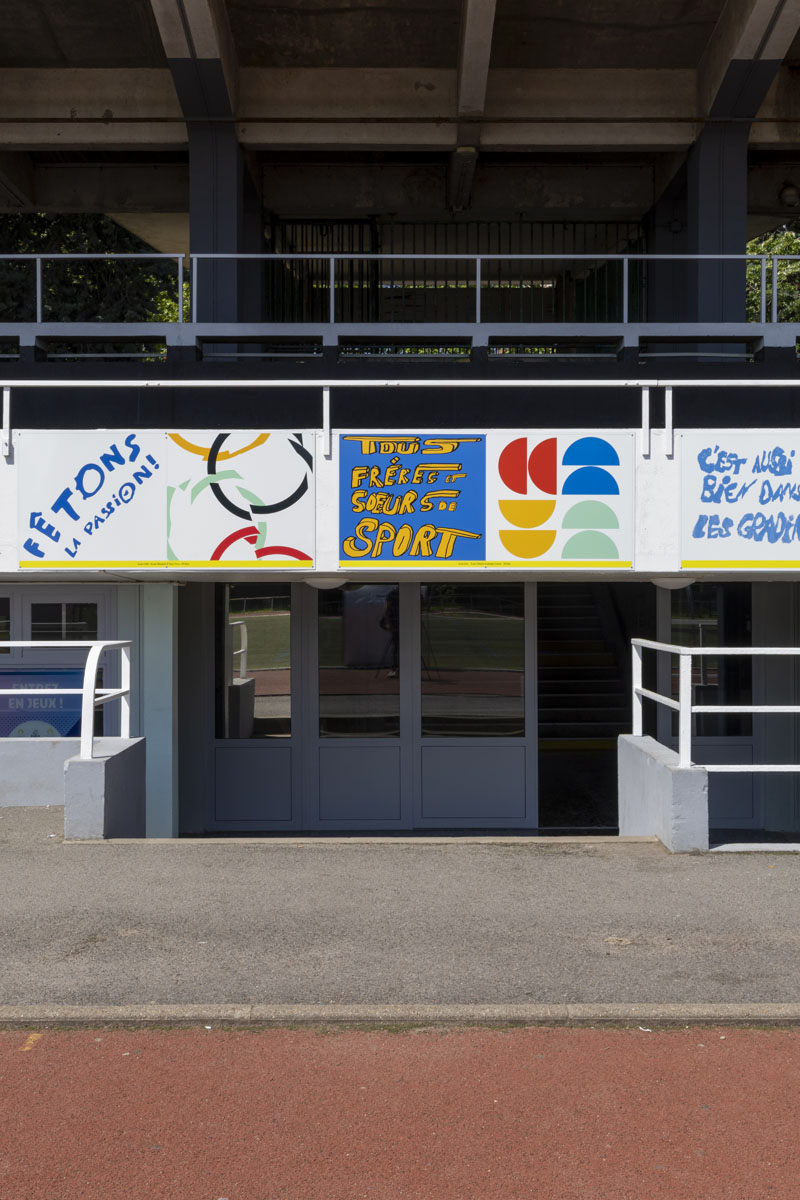
Esprit d’équipe, Louis Lumière sports center
Crédit photo :
Fred Mauviel / Ville de Paris
As part of the 24 artworks in sports facilities program, students from EPSAA designed a graphic animation for the Louis Lumière Stadium, the venue for the festivities in the 20th arrondissement during the Olympic and Paralympic Games. For this project, several meetings and a creative workshop were organized between the EPSAA students and the fifth-grade students from Riblette school to foster a writing project on the theme of the Games. This work was incorporated into the graphics designed by the students, bringing unique creations to life. A selection of these works is installed at the Louis Lumière Stadium.
Vidéo Youtube
Access to the sports center is reserved for clubs and associations.
We want to hear from you!
Was this information useful to you?
Please note: we cannot reply via this form (please do not include any personal information).

